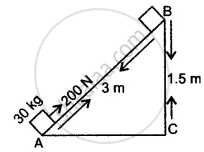Advertisements
Advertisements
प्रश्न
उत्तर
APPEARS IN
संबंधित प्रश्न
State the energy transformation on the following:
Electricity is obtained from solar energy.
Give one example each in which a force does (a) positive work (b) negative work, and (c) zero work.
How much work is done when a force of 1 N moves a body through a distance of 1 m in its own direction?
When do we say that work is done? Write the formula for the work done by a body in moving up against gravity. Give the meaning of each symbol which occurs in it.
Why does a spanner have a long handle?
Complete the following sentences:
The SI unit of work is ....... and of power is .......
A woman pulls a bucket of water of total mass 5 kg from a well which is 10 s. calculate the power used by her.
Calculate the amount of work done by a child carrying a bag of 20 kg when he moves a distance of 40 m in
(a) Vertical direction, and
(b) Horizontal direction
Give an example
Light energy changes to electrical energy.
Define Translational motion.
In what way does an ‘Ideal machine’ differ from a ‘Practical machine’?
What are the advantages and disadvantages of using solar cells for producing electricity?
A block of mass 30 kg is pulled up a slope, as shown in diagram with a constant speed, by applying a force of 200 N parallel to slope.
A and B are initial and final positions of block.

(i) Calculate the work done by force in moving the block from A to B.
(ii) Calculate P.E. gained by block. [g=10ms-2]
(i) A 200g ball is thrown vertically upward with an initial velocity of 30 ms-1. Draw a velocity-time graph for the motion of ball.
(ii) How long will the ball take to reach the highest point?
(iii) What will be the kinetic energy of ball, when it returns to the starting point, neglecting the air resistance?
(iv) What will be the potential energy of ball at highest point?
